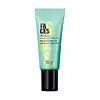What's inside
What's inside
 Key Ingredients
Key Ingredients

No key ingredients
 Benefits
Benefits

 Concerns
Concerns

 Ingredients Side-by-side
Ingredients Side-by-side

Water
Skin ConditioningDimethicone
EmollientIsododecane
EmollientAlcohol
AntimicrobialPropanediol
SolventTalc
AbrasiveGlycerin
HumectantCetyl PEG/PPG-10/1 Dimethicone
EmulsifyingCI 77891
Cosmetic ColorantLauryl PEG-10 Tris(Trimethylsiloxy)Silylethyl Dimethicone
EmulsifyingSilica Dimethyl Silylate
EmollientSalicylic Acid
MaskingTriethanolamine
BufferingDisteardimonium Hectorite
StabilisingPhenoxyethanol
PreservativeZinc PCA
HumectantMagnesium Sulfate
CI 77288
Cosmetic ColorantPropylene Carbonate
SolventBisabolol
MaskingTocopheryl Acetate
AntioxidantDisodium EDTA
Alumina
AbrasiveTocopherol
AntioxidantPentaerythrityl Tetra-Di-T-Butyl Hydroxyhydrocinnamate
AntioxidantWater, Dimethicone, Isododecane, Alcohol, Propanediol, Talc, Glycerin, Cetyl PEG/PPG-10/1 Dimethicone, CI 77891, Lauryl PEG-10 Tris(Trimethylsiloxy)Silylethyl Dimethicone, Silica Dimethyl Silylate, Salicylic Acid, Triethanolamine, Disteardimonium Hectorite, Phenoxyethanol, Zinc PCA, Magnesium Sulfate, CI 77288, Propylene Carbonate, Bisabolol, Tocopheryl Acetate, Disodium EDTA, Alumina, Tocopherol, Pentaerythrityl Tetra-Di-T-Butyl Hydroxyhydrocinnamate
Water
Skin ConditioningC13-15 Alkane
SolventGlycerin
HumectantHydrogenated Polyisobutene
EmollientPolyglyceryl-3 Polyricinoleate
EmulsifyingLauroyl Lysine
Skin ConditioningCaprylic/Capric Triglyceride
MaskingPropanediol
Solvent1,2-Hexanediol
Skin ConditioningDisteardimonium Hectorite
StabilisingMagnesium Sulfate
Panthenol
Skin ConditioningLinoleic Acid
CleansingPhospholipids
Skin ConditioningPhytosterols
Skin ConditioningBisabolol
MaskingZingiber Officinale Root Extract
MaskingWater, C13-15 Alkane, Glycerin, Hydrogenated Polyisobutene, Polyglyceryl-3 Polyricinoleate, Lauroyl Lysine, Caprylic/Capric Triglyceride, Propanediol, 1,2-Hexanediol, Disteardimonium Hectorite, Magnesium Sulfate, Panthenol, Linoleic Acid, Phospholipids, Phytosterols, Bisabolol, Zingiber Officinale Root Extract
Ingredients Explained
These ingredients are found in both products.
Ingredients higher up in an ingredient list are typically present in a larger amount.
Bisabolol is famous for its skin soothing properties. It does this by blocking inflammatory signals, helping to reduce your body's reaction to irritation.
This ingredient also interferes with the process of hyperpigmentation. This can help with reducing dark spots and uneven tone.
Bisabolol is an antioxidant. Antioxidants help fight free-radicals. Free-radicals are molecules that may damage your skin cells. By fighting these free-radicals, Bisabolol may slow down signs of aging.
Studies have shown Bisabolol to have antimicrobial properties and may be a fungicide. These properties help preserve a product's shelf life.
All these properties makes bisabolol a great skin barrier helper ingredient.
Bisabolol also helps the absorption of other ingredients.
Note: Synthetic Bisabolol has been shown to be less effective.
Learn more about BisabololDisteardimonium Hectorite comes from the clay mineral named hectorite. It is used to add thickness to a product.
It can also help stabilize a product by helping to disperse other ingredients.
Hectorite is a rare, white clay mineral.
Learn more about Disteardimonium HectoriteGlycerin is already naturally found in your skin. It helps moisturize and protect your skin.
A study from 2016 found glycerin to be more effective as a humectant than AHAs and hyaluronic acid.
As a humectant, it helps the skin stay hydrated by pulling moisture to your skin. The low molecular weight of glycerin allows it to pull moisture into the deeper layers of your skin.
Hydrated skin improves your skin barrier; Your skin barrier helps protect against irritants and bacteria.
Glycerin has also been found to have antimicrobial and antiviral properties. Due to these properties, glycerin is often used in wound and burn treatments.
In cosmetics, glycerin is usually derived from plants such as soybean or palm. However, it can also be sourced from animals, such as tallow or animal fat.
This ingredient is organic, colorless, odorless, and non-toxic.
Glycerin is the name for this ingredient in American English. British English uses Glycerol/Glycerine.
Learn more about GlycerinMagnesium Sulfate is a salt. More specifically, it is an epsom salt, or the bath salt used to help relieve muscle aches.
Despite having ‘sulfate’ in the name, it isn’t a surfactant or cleansing agent like sodium lauryl sulfate. Unlike those sulfates, magnesium sulfate doesn’t have the same cleansing or foaming properties (it's simply a type of salt).
In cosmetics, Magnesium Sulfate is used to thicken a product or help dilute other solids. It is a non-reactive and non-irritating ingredient.
One study shows magnesium deficiency may lead to inflammation of the skin. Applying magnesium topically may help reduce inflammation.
You can find this ingredient in sea water or mineral deposits.
Learn more about Magnesium SulfatePropanediol is an all-star ingredient. It softens, hydrates, and smooths the skin.
It’s often used to:
Propanediol is not likely to cause sensitivity and considered safe to use. It is derived from corn or petroleum with a clear color and no scent.
Learn more about PropanediolWater. It's the most common cosmetic ingredient of all. You'll usually see it at the top of ingredient lists, meaning that it makes up the largest part of the product.
So why is it so popular? Water most often acts as a solvent - this means that it helps dissolve other ingredients into the formulation.
You'll also recognize water as that liquid we all need to stay alive. If you see this, drink a glass of water. Stay hydrated!
Learn more about Water